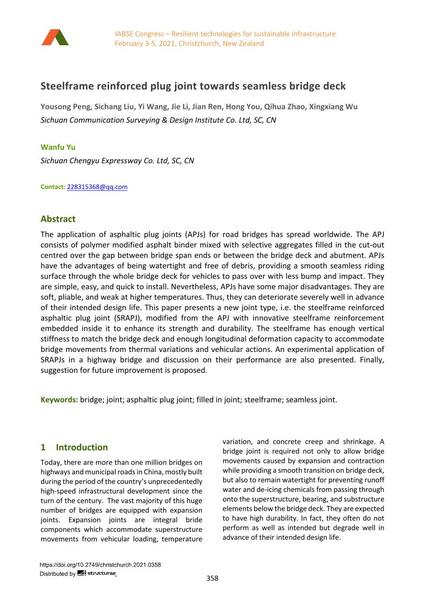Steelframe reinforced plug joint towards seamless bridge deck

|
|
|||||||||||
Détails bibliographiques
| Auteur(s): |
Yousong Peng
(Sichuan Communication Surveying & Design Institute Co. Ltd, SC, CN)
Sichang Liu (Sichuan Communication Surveying & Design Institute Co. Ltd, SC, CN) Yi Wang (Sichuan Communication Surveying & Design Institute Co. Ltd, SC, CN) Jie Li (Sichuan Communication Surveying & Design Institute Co. Ltd, SC, CN) Jian Ren (Sichuan Communication Surveying & Design Institute Co. Ltd, SC, CN) Hong You (Sichuan Communication Surveying & Design Institute Co. Ltd, SC, CN) Qihua Zhao (Sichuan Communication Surveying & Design Institute Co. Ltd, SC, CN) Xingxiang Wu (Sichuan Communication Surveying & Design Institute Co. Ltd, SC, CN) Wanfu Yu (Sichuan Chengyu Expressway Co. Ltd, SC, CN) |
||||
|---|---|---|---|---|---|
| Médium: | papier de conférence | ||||
| Langue(s): | anglais | ||||
| Conférence: | IABSE Congress: Resilient technologies for sustainable infrastructure, Christchurch, New Zealand, 3-5 February 2021 | ||||
| Publié dans: | IABSE Congress Christchurch 2020 | ||||
|
|||||
| Page(s): | 358-365 | ||||
| Nombre total de pages (du PDF): | 8 | ||||
| DOI: | 10.2749/christchurch.2021.0358 | ||||
| Abstrait: |
The application of asphaltic plug joints (APJs) for road bridges has spread worldwide. The APJ consists of polymer modified asphalt binder mixed with selective aggregates filled in the cut-out centred over the gap between bridge span ends or between the bridge deck and abutment. APJs have the advantages of being watertight and free of debris, providing a smooth seamless riding surface through the whole bridge deck for vehicles to pass over with less bump and impact. They are simple, easy, and quick to install. Nevertheless, APJs have some major disadvantages. They are soft, pliable, and weak at higher temperatures. Thus, they can deteriorate severely well in advance of their intended design life. This paper presents a new joint type, i.e. the steelframe reinforced asphaltic plug joint (SRAPJ), modified from the APJ with innovative steelframe reinforcement embedded inside it to enhance its strength and durability. The steelframe has enough vertical stiffness to match the bridge deck and enough longitudinal deformation capacity to accommodate bridge movements from thermal variations and vehicular actions. An experimental application of SRAPJs in a highway bridge and discussion on their performance are also presented. Finally, suggestion for future improvement is proposed. |
||||
| Mots-clé: |
pont
|
||||
